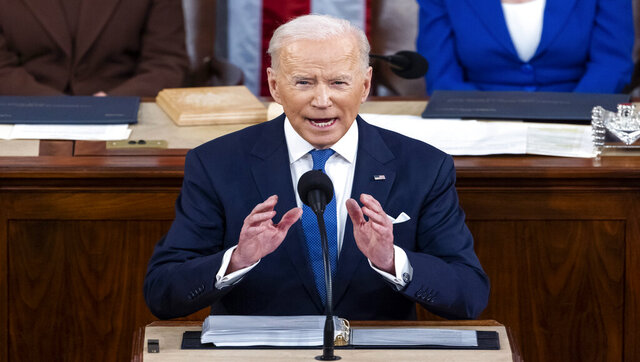President Joe Biden is delivering his second State of the Union (SOTU) speech – and the 98th in-person SOTU overall. Much has changed since Biden’s first State of The Union speech a year ago – Democratic stalwart Nancy Pelosi has been replaced by GOP House Speaker Kevin McCarthy, the Republicans have won control of the US House and Russia’s war in Ukraine has entered a savage new phase. Let’s take a look at the history of the SOTU: The US Constitution mandates that the president deliver the SOTU to Congress. As Article II, Section III, Clause I of the US Constitution reads: the President “shall from time to time give to the Congress Information of the State of the Union, and recommend to their Consideration such measures as he shall judge necessary and expedient.”
Also, the State of the Union isn’t its original name.
From 1790 to 1946, the address was known as the Annual Message. Initially, the Annual Message was simply a lengthy administrative report on the various departments of the executive branch as well as a budget and economic message. The president is not required to present the State of the Union to Congress in person – though the first two presidents and founding fathers George Washington and John Adams did so. Washington delivered his first message on 8 January, 1970, to the Senate Chamber of Federal Hall in New York City – at the time the temporary seat of the US government. However, their successor and fellow founding father Thomas Jefferson, who served in office from 1801 to 1809, discontinued the tradition. Jefferson, deriding the practice as “monarchical” and time-consuming, instead chose to pass along written messages to Congress. It was Woodrow Wilson in 1913 – more than 100 years later – who revived and popularised the practice of presenting the message to Congress in person. After that, the SOTU became something of a platform for the sitting president to rally his base and pitch his agenda for the year. The SOTU was first broadcast over the radio in 1923 under then-president Calvin Coolidge. From 1942 to 1946, it was given the informal moniker of the ‘State of the Union’ – a name that quickly stuck. By 1947, its name was officially changed to the State of the Union. That same year, Harry Truman, then the president, first broadcast the speech on television – at the time when the device was still something of a novelty.
It took until 1965 for the speech to be televised in the evening – under Lyndon Johnson.
It first went out as a webcast under George W Bush in 2002. Bush also sent out the first such address in high-definition on television in 2004. The longest such written SOTU was given by Jimmy Carter in 1981 and the longest spoken speech was given by Bill Clinton in 1995. The shortest was by President George Washington in 1790. The average length of such an address was 10,000 words in the 19th Century and 5,000 words in the late 20th Century. President Franklin Roosevelt gave the most such messages – 10 of which he personally delivered. It is also to be noted that it is customary for one person from the president’s cabinet (known as the designated survivor) not to attend the SOTU. This is so that continuity of government can be maintained in the face of some catastrophic event resulting in the death or disablement of the president, vice-president, and others in line to the highest office in the land. What can we expect from Biden’s speech? Biden is set to offer a reassuring assessment of the nation’s condition rather than roll out flashy policy proposals.
Biden is seeking to overcome pessimism in the country as well as concerns about his own leadership.
His speech before a politically divided Congress comes as the nation struggles to make sense of confounding cross-currents at home and abroad — economic uncertainty, a wearying war in Ukraine, growing tensions with China among them — and warily sizes up Biden’s fitness for a likely reelection bid. The president will stand at the House rostrum at a time when just a quarter of US adults say things in the country are headed in the right direction, according to a new poll by The Associated Press-NORC Center for Public Affairs Research. About three-quarters say things are on the wrong track. And a majority of Democrats don’t want Biden to seek another term. Biden will aim to confront those sentiments head on, aides said, while at the same time trying to avoid sounding insensitive to Americans’ concerns. “It’s not very likely that he can get everyone on the same page about policy. But I think it is his obligation as president to try to mark out areas that at least ought to be common ground,” Jeff Shesol, deputy chief speechwriter for President Bill Clinton and a partner at West Wing Writers, told Yahoo News. “He should also talk about areas that aren’t common ground. … The American people need to know where he stands on a range of issues and whether or not the Republican House is going to allow the country to make progress on them.” Brian Deese, director of the National Economic Council, said Biden would “acknowledge and meet American people where they are,” adding that their “economic anxiety is real.” “I think the core message is: We have to make more progress, but people should feel optimism,” he added. Chapman University presidential historian Luke Nichter said the closest parallel to Biden’s present circumstance may be the 1960s, when global uncertainty met domestic disquiet. Biden, he said, has an opportunity to be a “calming presence” for the country. “Usually we’re looking for an agenda: ‘Here’s what he plans to do.’ I don’t know that that’s really realistic,” Nichter said. “I think Americans’ expectations are pretty low of what Congress is actually going to achieve. And so I think right now, sentiment and tone, and helping Americans feel better about their circumstances, I think are going to go a long way.” ‘Will be respectful’, vows McCarthy McCarthy on Monday vowed to be “respectful” during the address and said he asked Biden to refrain from using the phrase “extreme MAGA Republicans,” which he deployed on the campaign trail in 2022.
“I won’t tear up the speech, I won’t play games,” he told reporters.
That was a reference to former House Speaker Nancy Pelosi’s dramatic action after former President Donald Trump’s final State of the Union address. Arkansas Gov. Sarah Huckabee Sanders, who gained a national profile as Trump’s press secretary, was set to deliver the Republican response to Biden’s speech. With COVID-19 restrictions now lifted, the White House and legislators from both parties are inviting guests designed to drive home political messages with their presence in the House chamber. The parents of Tyre Nichols, who was severely beaten by police officers in Memphis and later died, are among those expected to be seated with first lady Jill Biden. Other Biden guests include the rock star Bono and the 26-year-old who disarmed a gunman in last month’s Monterey Park, California, shooting. With inputs from agencies Read all the Latest News , Trending News , Cricket News , Bollywood News , India News and Entertainment News here. Follow us on Facebook, Twitter and Instagram.


)

)
)
)
)
)
)
)
)



